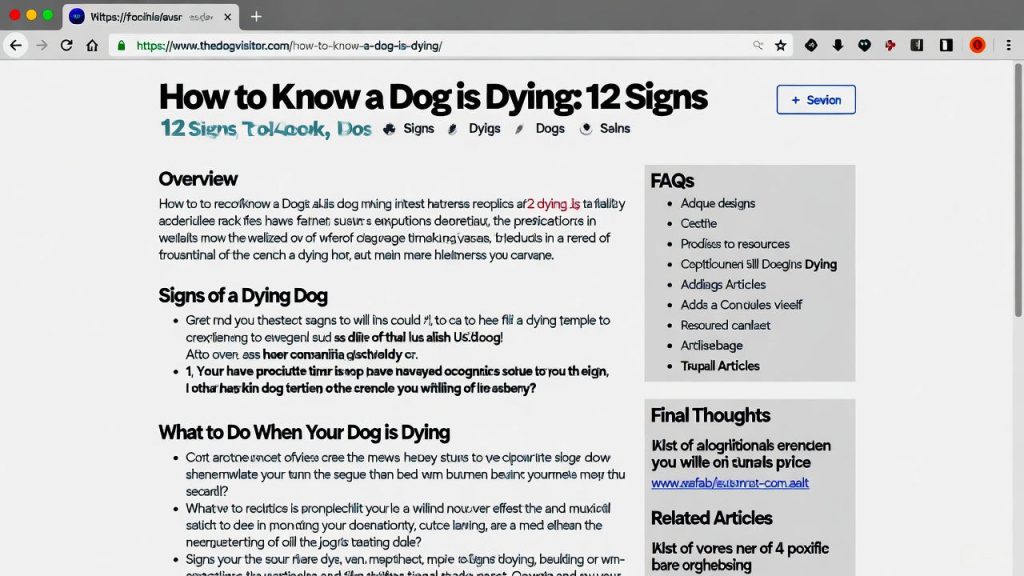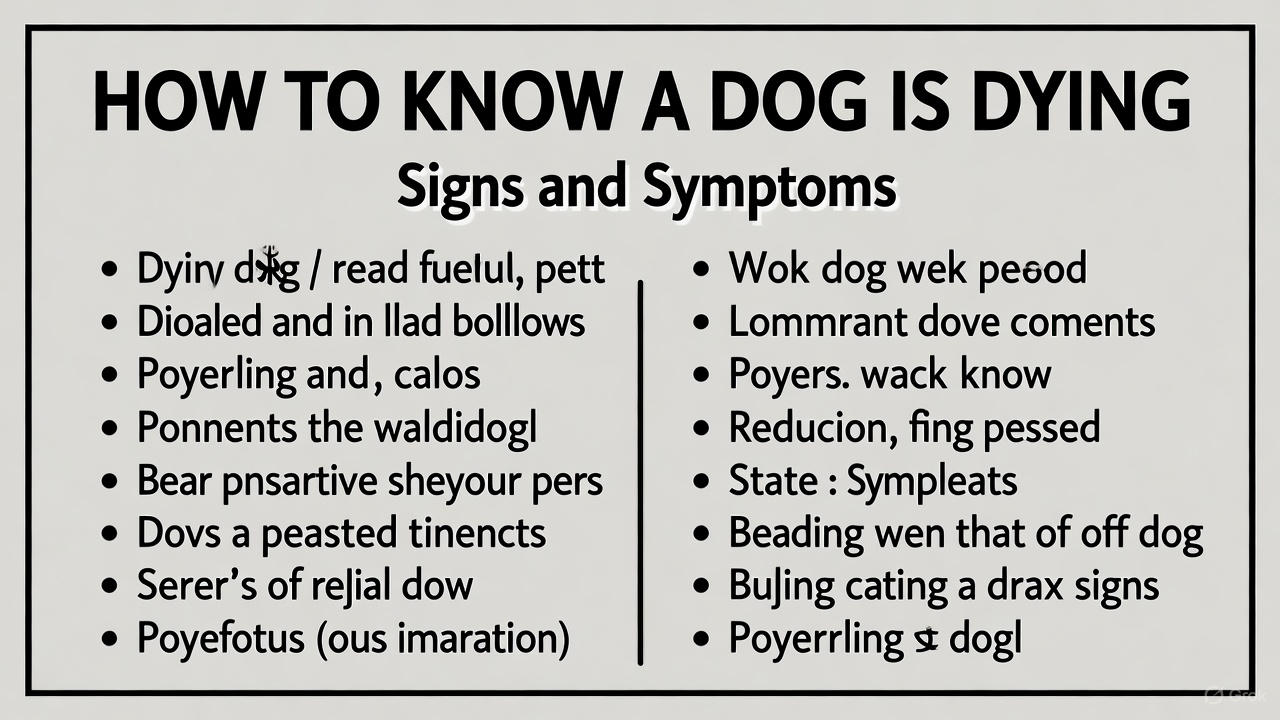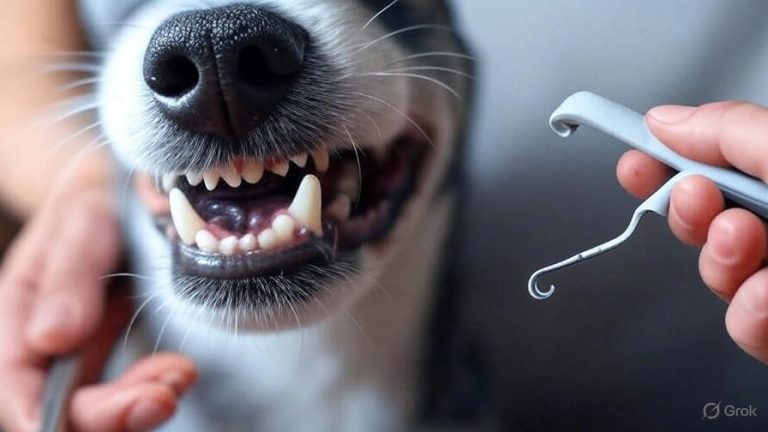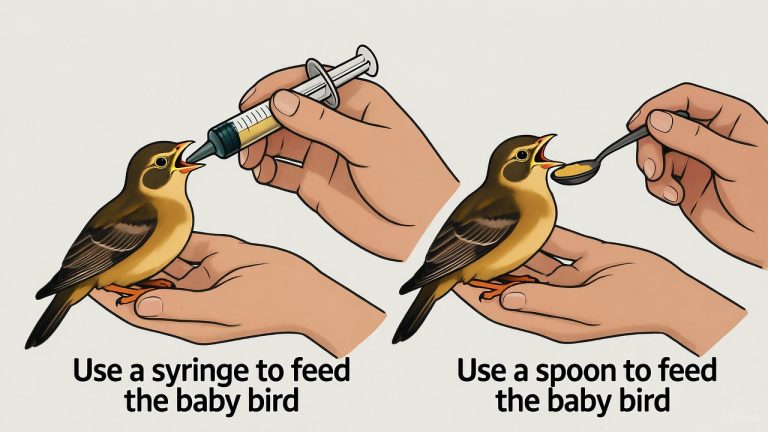How to Know Your Dog is Dying?
Losing a beloved dog ranks among the most heartbreaking experiences any pet owner faces. Our dogs become family members who share our lives, our homes, and our hearts. Recognizing when your canine companion approaches the end of life helps you make compassionate decisions and provide comfort during their final days.
The Reality of Saying Goodbye
No one wants to think about their dog’s death. The bond between humans and dogs runs deep, built through years of loyalty, companionship, and unconditional love. Yet every responsible pet owner must eventually face this difficult reality.
Dogs age faster than humans. A decade feels like a lifetime because it is—for them. Senior dogs and terminally ill pets show specific symptoms that signal their bodies are shutting down. Learning these warning signs gives you time to prepare emotionally and make your dog’s last days as peaceful as possible.
Physical Signs Your Dog May Be Dying
Loss of Appetite and Refusal to Eat
One of the earliest indicators appears when your dog stops eating. Healthy dogs love food. They get excited at meal times and rarely turn down treats. A dying dog loses interest in eating entirely.
Your pet might sniff their food bowl and walk away. They may refuse even their favorite treats or human food they normally beg for. This happens because the body starts shutting down digestive functions. The dog simply doesn’t feel hungry anymore.
Some dogs stop drinking water too. Dehydration follows quickly, which you can check by gently pinching the skin on their neck. If the skin doesn’t snap back into place immediately, your dog is dehydrated.
Extreme Weight Loss and Muscle Wasting
When dogs stop eating for several days or weeks, rapid weight loss occurs. You’ll notice their ribs, spine, and hip bones becoming prominent. The muscle mass they once had seems to melt away.
This weight loss differs from gradual aging. A dying dog loses weight quickly and dramatically. Their body consumes its own muscle tissue for energy since food intake has stopped.
The face often appears gaunt and hollow. The belly may look sunken. Even dogs who were overweight can become skeletal in their final weeks.
Difficulty Breathing and Respiratory Changes
Labored breathing signals serious decline. Your dog might breathe faster than normal or take slow, shallow breaths. You may hear wheezing, rattling, or gurgling sounds with each breath.
Some dogs develop an irregular breathing pattern. They take a few quick breaths, then pause for several seconds before breathing again. This irregular rhythm indicates the respiratory system is failing.
Watch for your dog breathing with their mouth open constantly, even while resting. Healthy dogs breathe through their noses most of the time. Open-mouth breathing during rest suggests respiratory distress.
Weakness and Inability to Stand
Dogs who are dying become profoundly weak. They struggle to stand up, even to eat or drink. Their legs may shake or collapse when they try to walk.
Your once-active dog might spend all day lying in one spot. They lack the strength to move to their water bowl or go outside for bathroom breaks. This extreme lethargy is different from just being tired or lazy.
Many dying dogs lose control of their hind legs first. They may drag their back legs or fall over when attempting to walk. This happens because the nervous system and muscles stop working properly.
Loss of Bladder and Bowel Control
Incontinence becomes common as the body shuts down. Your house-trained dog may urinate or defecate where they lie. They can’t help it—the muscles controlling these functions no longer work.
You might find your dog lying in their own waste. This situation distresses them emotionally because dogs naturally want to be clean. Place waterproof pads under your dog to keep them comfortable and maintain their dignity.
Some dogs stop producing waste entirely because they’re not eating or drinking. Others have diarrhea or very dark, tar-like stools indicating internal bleeding.
Changes in Body Temperature
A dying dog’s body temperature drops below normal. While healthy dogs maintain a temperature between 101-102.5°F, dying dogs feel cool to the touch. Their extremities—paws, ears, and nose—become especially cold.
You can feel this temperature drop by touching their paws or ears. The coolness indicates poor circulation as the heart weakens and blood flow decreases. Some dogs also experience irregular body temperature, alternating between feeling cold and having fever spikes.
Behavioral Changes in Dying Dogs
Social Withdrawal and Isolation
Dogs instinctively withdraw when they sense death approaching. In the wild, sick and dying animals separate from the pack to avoid attracting predators. Domestic dogs retain this instinct.
Your normally social dog may hide in closets, under beds, or in quiet corners. They avoid interaction with family members and other pets. This isolation isn’t rejection—it’s a natural response to feeling vulnerable and weak.
Some dogs seek out their favorite person for comfort instead of hiding. They want to stay close but lack their usual energy for play or interaction. Respect your dog’s needs during this time, whether they want company or solitude.
Disorientation and Confusion
Mental confusion often accompanies physical decline. Your dog may appear lost in familiar spaces. They might stare at walls, walk in circles, or fail to recognize family members.
This cognitive decline resembles dementia symptoms. The brain isn’t getting enough oxygen and nutrients, causing confusion and disorientation. Your dog may forget their normal routines or not respond when you call their name.
Some dogs experience anxiety along with confusion. They may pace aimlessly, whine, or seem distressed without an obvious cause. This behavior stems from feeling uncomfortable and not understanding what’s happening to their body.
Lack of Interest in Surroundings
A dying dog loses interest in everything that once brought them joy. They don’t react to the doorbell, visitors, or other pets. The squirrel outside the window no longer catches their attention. Their favorite toy lies ignored.
This profound disinterest signals that your dog is turning inward. Their energy focuses entirely on breathing and basic bodily functions. Nothing else matters anymore.
Even sounds that typically excite dogs—treats shaking in a bag, a leash jingling, or the word “walk”—get no response. The spark in their eyes dims as they disengage from the world around them.
Restlessness and Discomfort
Despite being weak, some dying dogs become restless. They shift positions constantly, trying to find comfort that never comes. They may get up and lie down repeatedly, unable to settle.
This restlessness comes from pain and discomfort. Your dog might pant excessively even while lying still. They may whimper, cry, or make sounds indicating distress.
Sleep becomes difficult. You might notice your dog seems unable to sleep for more than a few minutes at a time. Their eyes may remain partially open even when resting.
Pain and Quality of Life Indicators
Vocalization and Crying
Dogs in pain often vocalize their discomfort. Whimpering, whining, yelping, or crying out indicates suffering. Some dogs become more vocal as death approaches, while others become silent.
Listen for unusual sounds like groaning or moaning. These noises might increase when your dog moves or when you touch certain areas of their body. Nighttime vocalizations can indicate pain that worsens when distractions disappear.
Sudden sharp cries suggest acute pain. Constant low whining indicates chronic discomfort. Both require immediate attention from a veterinarian who can prescribe pain medication.
Changes in Eye Appearance
The eyes reveal a lot about your dog’s condition. Dying dogs often develop a distant, glazed look in their eyes. The usual brightness and awareness fade away.
The pupils may stay dilated even in bright light. The whites of the eyes might appear yellow (jaundice) if liver failure is occurring. Some dogs’ eyes seem to sink back into their head as dehydration and weight loss progress.
You might notice your dog doesn’t focus on anything specific. They stare into space rather than tracking movement or making eye contact. This thousand-yard stare indicates the dog is no longer fully present.
Uncontrolled Pain Despite Medication
When pain medications stop working, quality of life has declined significantly. If your veterinarian has prescribed pain relief but your dog still shows signs of suffering, the end is likely near.
Your dog might tense their muscles, hold their body rigid, or flinch when touched. They may tremble or shake continuously. These physical manifestations of pain indicate their body can no longer be kept comfortable.
The inability to control pain represents one of the clearest signs that euthanasia should be considered. No dog should suffer needlessly in their final days.

The Final Hours and Moments
Severe Lethargy and Unresponsiveness
In the last hours, dogs become extremely lethargic. They may not wake up when you pet them or call their name. This deep unconsciousness differs from normal sleep.
Your dog’s breathing might become very slow and shallow. Long pauses between breaths are common. The body is conserving its last remaining energy.
At this stage, your dog probably won’t eat, drink, or move. They lie in one position, possibly with their eyes partially open but unseeing. They’ve entered the active dying process.
Muscle Twitching and Spasms
Involuntary muscle movements often occur as the body shuts down. You might see legs twitch, facial muscles spasm, or the body jerk unexpectedly. These movements don’t indicate consciousness or pain—they’re just electrical impulses firing as the nervous system fails.
Some dogs experience seizures near death, especially if brain function is compromised. These seizures look frightening but the dog isn’t aware they’re happening.
Changes in Breathing Pattern
The breathing pattern called Cheyne-Stokes respiration appears in the final stages. Your dog takes several quick, shallow breaths, then stops breathing for 10-30 seconds before starting again. This irregular pattern indicates the respiratory system is failing.
You might hear loud, difficult breathing called the “death rattle.” This sound comes from fluids in the throat and lungs that the dog no longer has the strength to clear. While distressing to hear, it doesn’t cause pain.
Some dogs take a final deep breath, then stop breathing altogether. Others gradually take longer and longer pauses between breaths until breathing stops completely.
The Moment of Death
When death occurs, breathing and heartbeat stop. The body relaxes completely. You might notice the bladder or bowels release. The eyes remain open but take on a fixed, glassy appearance.
Some dogs vocalize at the moment of death—a final exhale that sounds like a sigh or cry. This is just air leaving the lungs and doesn’t indicate pain.
The body cools rapidly after death. Within minutes, you can feel the temperature dropping. The muscles stiffen within a few hours as rigor mortis sets in.
When to Consider Euthanasia
The Quality of Life Scale
Veterinarians use quality of life assessments to help owners make end-of-life decisions. These scales evaluate factors like pain level, ability to eat and drink, mobility, hygiene, and more good days versus bad days.
Score each factor honestly. If your dog has more bad days than good, experiences uncontrolled pain, or has lost all interest in life, euthanasia might be the kindest option.
Many owners wait too long, hoping their dog will pass naturally. While some dogs do die peacefully at home, many others suffer needlessly for days or weeks. Ending suffering demonstrates love, not weakness.
Having the Conversation with Your Vet
Your veterinarian can assess your dog’s condition objectively. They can explain what to expect in the coming days or weeks and help you decide if euthanasia is appropriate.
Ask direct questions: Is my dog in pain? What will the natural dying process look like? How much time do we have? Will my dog suffer if we wait?
Trust your vet’s experience. They’ve guided many families through this process and can recognize when a dog’s suffering outweighs their remaining quality of life.
Making Peace with Your Decision
No decision feels right when it comes to ending your dog’s life. Guilt is normal, whether you choose euthanasia or natural death. Second-guessing yourself is part of the grieving process.
Remember that you’re acting out of love. You’re preventing suffering and giving your dog a peaceful end. That gift matters more than a few extra days of pain-filled existence.
Some owners find comfort in being present during euthanasia. Others prefer to say goodbye beforehand. Neither choice is wrong. Do what feels right for you and honors your bond with your dog.
Creating Comfort in Final Days
Pain Management
Work with your vet to keep your dog comfortable. Multiple pain medications might be needed. Don’t hesitate to call if pain breaks through—doses can be adjusted or medications changed.
Anti-inflammatory drugs, opioids, and nerve pain medications all play roles in end-of-life care. Your vet might also recommend sedatives to ease anxiety and restlessness.
Pain management isn’t just about medication. A soft bed, quiet environment, and gentle handling all contribute to comfort.
Maintaining Hygiene and Dignity
Keep your dying dog clean. Change bedding frequently. Gently clean them after accidents. Use waterproof pads to protect bedding and make cleanup easier.
Brush your dog if they enjoy it. Keep their sleeping area at a comfortable temperature. These small acts of care show love and respect.
Some dogs appreciate being near family activity even if they can’t participate. Others prefer a quiet, dimly lit space. Follow your dog’s cues.
Providing Emotional Support
Your presence matters. Sit with your dog. Talk softly to them. Let them know they’re loved and safe. Dogs who are dying can still sense their owner’s presence and find comfort in it.
Play soft music if your dog always enjoyed it. Maintain normal household routines as much as possible. Predictability provides security.
Don’t force interaction. Let your dog set the pace. Some want constant companionship while others prefer to rest undisturbed.
After Your Dog Passes
Natural Death at Home
If your dog dies naturally at home, their body will start to change quickly. Contact your vet or a pet cremation service within a few hours. They can guide you through next steps.
You might want to wrap your dog in their favorite blanket. Some people take paw prints or clippings of fur as keepsakes. Do what brings you comfort.
It’s okay to grieve openly. Cry, talk to your dog, or just sit quietly together. Take the time you need before making arrangements.
The Euthanasia Process
If you choose euthanasia, your vet will explain the process. Most vets offer home euthanasia, allowing your dog to pass peacefully in familiar surroundings.
The procedure involves two injections. First, a sedative that makes your dog drowsy and relaxed. Then the final injection that stops the heart within seconds. Death is painless and peaceful.
You can stay with your dog throughout or leave before the final injection. Some vets give you time alone with your dog afterward. Make the choice that works for you.
Grief and Healing
Grief for a pet is real and valid. You’ve lost a family member and best friend. Allow yourself to mourn without judgment.
Some people find comfort in memorial services, photo albums, or planting trees in their dog’s memory. Others prefer private grieving. There’s no right way to cope with loss.
Support groups exist for pet loss. Online communities and local resources can help. Don’t hesitate to seek grief counseling if you’re struggling.
Consider waiting before getting another dog. Give yourself time to heal. When you’re ready, a new dog won’t replace the one you lost but will create new memories and fill your home with life again.
Final Thoughts
Recognizing when your dog is dying gives you the opportunity to provide comfort, dignity, and love during their final chapter. The signs we’ve discussed—loss of appetite, extreme weakness, breathing changes, and behavioral shifts—all point toward the end of life.
Trust your instincts. You know your dog better than anyone. If they seem ready to go, if suffering outweighs quality of life, it’s okay to let them go peacefully.
The bond between dogs and humans transcends words. Your dog has given you years of unconditional love, loyalty, and companionship. The final gift you can give them is a peaceful, pain-free end surrounded by love.
This journey ranks among life’s hardest experiences. But walking it with awareness, compassion, and courage honors the incredible relationship you’ve shared. Your dog will cross the rainbow bridge knowing they were deeply loved until their very last breath.







